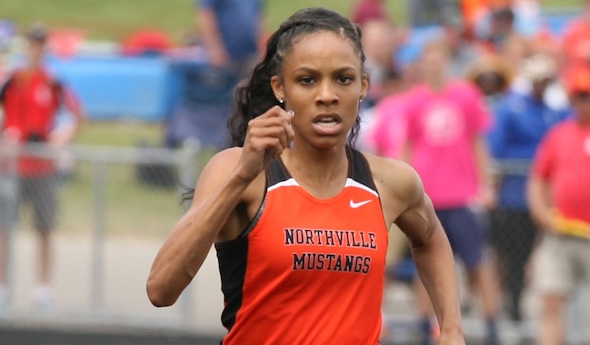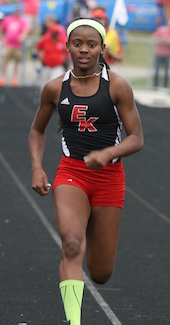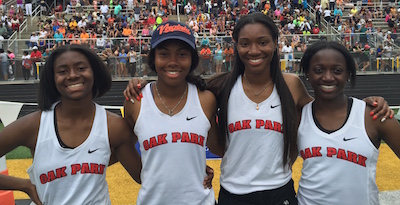
Northville's Abbott Takes Place with Stars
June 4, 2016
By Bill Khan
Special to Second Half
HUDSONVILLE — It was supposed to be the Sekayi Bracey and Anna Jefferson show.
And, to a great extent, it was.
Bracey added two more victories to her resume, finishing her outstanding career at East Kentwood with 10 individual championships in MHSAA track and field meets.
Jefferson led Oak Park to a third straight Lower Peninsula Division 1 team championship and all-division MHSAA Finals records in the 800 and 400 relays. The Knights had 81.5 points, while runner-up Ann Arbor Pioneer had 64.
While Bracey and Jefferson added to their legacies, Northville senior Chloe Abbott upstaged both all-time great Michigan sprinters by beating each of them head-to-head in events they've previously won.
First, Abbott ran 53.10 seconds to take down Jefferson in the 400-meter dash, an event Jefferson won in 2013 and 2014 before taking second in 2015. Jefferson took third Saturday.
Less than an hour later, Abbott pulled off a double that is extremely difficult under most circumstances, but more so considering her primary competition was going for her fourth MHSAA championship in the event. Yet, Abbott charged from behind to win the 200 in 24.03, while Bracey finished fourth in a race that featured six times of 24.51 seconds or faster.
Not yet worn out from those two exhausting races, Abbott anchored Northville to victory in the 1,600 relay, the final event, giving her three victories in the last six races of the day. She was also on the fourth-place 800 relay team, giving her a hand in 35 of third-place Northville's 50 points.
The first thing Abbott did after winning the 400 was try to forget about it.
 "I talked to my friends," she said. "I relaxed myself a little bit, kind of numbed myself to the 400 zone. If you think about it for a long time, you're like, 'Wow, I did so good in the 400.' You kind of get comfortable with it. I wanted to forget it and focus on the 200. I'm so glad I was able to pull out another win. I'm surprising myself today."
"I talked to my friends," she said. "I relaxed myself a little bit, kind of numbed myself to the 400 zone. If you think about it for a long time, you're like, 'Wow, I did so good in the 400.' You kind of get comfortable with it. I wanted to forget it and focus on the 200. I'm so glad I was able to pull out another win. I'm surprising myself today."
Abbott didn't have the MHSAA Finals pedigree of Bracey or Jefferson.
In 2013, when Bracey and Jefferson were winning championships as freshmen, Abbott was 27th in the 200, her only event that year. She took sixth in the 100 and ninth in the 200 as a sophomore, while helping Northville get two top-three finishes in relays. As a junior, she was third in the 400 and seventh in the 200, adding a third-place finish on the 1,600 relay.
Abbott didn't beat Jefferson in the 400 until last summer, after the high school season.
"Ever since then, I didn't want to get beat by her again," Abbott said. "So, I kept pushing and knew I could do it."
Abbott had never beaten Bracey until Saturday.
"I never even dreamed of beating Sekayi," Abbott said. "I knew how great she was. She hasn't had a lot of competition all season. I figured she was going to come out and push it today, because she finally has some competition. I was nervous about that, because she's very good. I wanted to make sure I got that out of my head, forget about the people and just focus on my race and what I can control."
Bracey lost in a 200 final only once in her four-year career before Saturday, that coming her freshman year when Rockford's Sammy Cuneo beat her in the Michigan Interscholastic Track Coaches Association Division 1 team championship meet.
"I don't even know what happened," Bracey said. "I was so frustrated when they were all coming up on me. I'm like, 'What's going on?' I never had that in my life. It was confusing."
Abbott and Bracey will be teammates at Purdue University beginning next season.
"I told her, '1 and 2, that's it, because now we're a team,'" Abbott said. "I wanted her and me to show out for Purdue and show out for our schools."
Bracey won the 100 for the fourth straight year in 12.08 seconds. She won her third long jump title with a leap of 18 feet, 10 inches. She jumped only once in the Finals to preserve herself for her track events.
Jefferson helped Oak Park break two all-division Finals records set by Detroit Mumford in 2005 with times of 1:36.66 in the 800 relay and 46.28 in the 400 relay.
 "That was special," Oak Park coach Brandon Jiles said. "We knew we could run fast in the 4x1 and 4x2. It was all about putting it on the track. Those times are the fastest times by far that have been run in the state. For those kids to run that fast, they were really rolling. Everything had paid off, the hard work."
"That was special," Oak Park coach Brandon Jiles said. "We knew we could run fast in the 4x1 and 4x2. It was all about putting it on the track. Those times are the fastest times by far that have been run in the state. For those kids to run that fast, they were really rolling. Everything had paid off, the hard work."
The Knights got off to a shaky start, with Jefferson failing to qualify for the championship race in the 100 hurdles and the 3,200 relay team placing out of the scoring with a ninth-place finish.
"It started out tough, but the kids were resilient and they fought and they showed they could win a tight meet, as opposed to a blowout like the last couple of years," Jiles said.
Oak Park's individual champions were sophomore Dorriann Coleman, who took the 800 in 2:10.20, and senior Brianna Holloway, who set a meet record in the 300 hurdles with a time of 42.71.
Greenville junior Landon Kemp was another of the stars of the meet. The highlight of her day was breaking the all-division Finals record in the pole vault with a leap of 13 feet, 4 inches. She also took second in the long jump at 18-5.5 and fifth in the 100 hurdles in 14.87.
Other individual champions were Ann Arbor Pioneer's Britten Bowen in the 100 hurdles (14.08); Port Huron's Rachel Bonner in the 1,600 (4:49.29); Farmington's Maddy Trevisan in the 3,200 (10:35.85); Grand Blanc's Quiara Wheeler in the discus (136-2); Grosse Pointe South's Kayli Johnson in the shot put (44-7.75); and Macomb Dakota's Kayla Dobies in the high jump (5-7).
Ann Arbor Pioneer won the 3,200 relay in 8:56.52.
PHOTOS: (Top) Northville's Chloe Abbott takes the lead on the way to one of her two championships Saturday. (Middle) East Kentwood's Sekayi Bracey won the ninth and 10th individual Finals titles of her career. (Below) Oak Park's 800 relay was among significant contributors to the team's overall LP Division 1 championship. (Photos by Carter Sherline and John Brabbs/RunMichigan.com.)

Hastings Relays Reigns as State's Oldest Continuous Track & Field Meet
By
Steve Vedder
Special for MHSAA.com
April 10, 2024
Bob Branch remembers dabbling in other sports, but his first love was always running.
 The Hastings High School graduate admits he could never hit a baseball, football didn't especially appeal to him and basketball was just another way to spend time with friends. But for Branch, now 93, there was always track. That's the sport where his fondest and sharpest memories remain. And if you're talking track, many of his favorite memories come from participation in the state's oldest continuous track meet, the Hastings Relays.
The Hastings High School graduate admits he could never hit a baseball, football didn't especially appeal to him and basketball was just another way to spend time with friends. But for Branch, now 93, there was always track. That's the sport where his fondest and sharpest memories remain. And if you're talking track, many of his favorite memories come from participation in the state's oldest continuous track meet, the Hastings Relays.
Always held in early April, the meet dates back to 1937 – a bygone time that saw the first hostilities of World War II, gas at 20 cents a gallon and a loaf of bread selling for a dime.
And at a dusty old track surrounding the county fairgrounds in Hastings, a small relay event that included a scattering of participants from a dozen high schools was taking its first tentative steps.
Branch recalls a time when kids would run home after track practice because there were no buses, inexperienced young coaches had little actual knowledge of running fundamentals, and athletes looked at the sport as an afterthought after spending most of their high school days playing football and basketball.
 For Branch, the relays were the ideal way to ease into the track season.
For Branch, the relays were the ideal way to ease into the track season.
"I just liked to run," said Branch. "I remember I anchored a relay with my brother, and it always seemed cold when we had that meet. I remember teams would come from all over and you saw a lot of good athletes. Everybody seemed to have someone who was really good. Track wasn't very popular at that time, but I have a lot of good memories from running."
The Hastings Relays, which has changed formats and even names during its nearly nine-decade history, would traditionally kick off the track season. The meet was originally held at a makeshift quarter-mile track which surrounded the town's fairgrounds and was part of the city's annual Hastings Carnival – the track would become the midway during fair time.
The meet eventually moved to Johnson Field when the football field was dedicated in 1949 and ballooned to as many as 50 teams at its peak in 1957. For more than seven decades it was known as the Hastings Relays and then the Hastings Co-Ed relays before becoming the current Hastings Invitational, with the latest edition scheduled for Friday.
Johnson Field had a cinder track before it became an all-weather surface in the 1980s. During a time long before computers would be used to organize meet heats in mere minutes, Hastings coaches of all sports – defined as "volunteers" by the athletic department – would meet on the Friday before competition to hash out events.
People associated with the meet still recall the camaraderie built on those long Friday nights, followed by working what would often become 10-hour meets. Steve Hoke has been involved since watching his father, Jack, who coached teams at 15 of the meets beginning in 1951 and also had run in the first Hastings Relays. Steve Hoke later competed in the Relays as well during the early 1970s before becoming an assistant track coach, later the Hastings athletic director and now a volunteer worker.
"It was always a huge deal," said Hoke, who said the meet began as a pure relay event before transitioning to its current team format in the 1990s. "I remember we'd line the track the night before, and all the coaches would come to the house to organize everything. There was a brotherhood.”
 If you quiz many of the fleet of volunteers who've worked the relays over the years, each has a different memory from the meet. While Hoke describes the brotherhood and Branch the outstanding competition, others remember weather and the time a thunderstorm wiped out the line markings on the cinder track, or waking up to find three inches of snow that caused a rare cancellation of the meet. Others recall the shock of moving from the cinder to all-weather track or using the meet as an early measuring stick of what it would take to qualify for the state meet. The real old-timers remember the meet disappearing for three years during World War II.
If you quiz many of the fleet of volunteers who've worked the relays over the years, each has a different memory from the meet. While Hoke describes the brotherhood and Branch the outstanding competition, others remember weather and the time a thunderstorm wiped out the line markings on the cinder track, or waking up to find three inches of snow that caused a rare cancellation of the meet. Others recall the shock of moving from the cinder to all-weather track or using the meet as an early measuring stick of what it would take to qualify for the state meet. The real old-timers remember the meet disappearing for three years during World War II.
Hastings native and Western Michigan grad Tom Duits was the state’s second collegian to break the four-minute mile when he ran a 3:59.2 at a meet in Philadelphia in 1978. Duits, who ran in three Hastings Relays, was in line to join the U.S. Olympic team in 1980 before the United States pulled out of the games due to tension with Russia.
Duits has his own memories of the meet and the competition he faced there.
"I remember sunshine and being excited to be competing again. There were all these athletes swarming around; it was an awesome display of talent," he said. "It was always one of the best meets we'd be in. You could pretty much see the level of runners who would be at state, which made it a big deal. It was always early, but you could tell where you stood. It was great exposure."
Hastings track star Wayne Oom competed in four Hastings Relays from 1984-87. One of his sharpest memories was the difference between running on a raw cinder track versus the far more comfortable all-weather surface.
"Those cinders would grind into your skin," said Oom, part of the Hastings school record in the two-mile relay. "But I think it helped us because when we'd go to other tracks, it seemed we would run faster. I remember how competitive it was, especially in the distances. There were some great runners."
While participants have their unique memories, so do coaches. Former Saxons coach Paul Fulmer remembers 2008 when his team finished first on the boys side of the meet while his wife, Grand Haven coach Katie Kowalczyk-Fulmer, saw her girls team win the championship.
 "I knew we were one of the favorites to win because we were usually near the top of our conference and Regional," he said. "But then Katie's team was pretty good, and it was cool for them to win too."
"I knew we were one of the favorites to win because we were usually near the top of our conference and Regional," he said. "But then Katie's team was pretty good, and it was cool for them to win too."
Fulmer, who coached Hastings from 1978-81 and then 1985-2010, said at least part of the meet's popularity was derived from a unique way of scoring. Instead of individuals earning points solo, participants worked in pairs. For instance, two athletes would combine their shot put or long jump scores. New events such as the 1,500 relay and sprint medley were added.
"We had a tradition of being the state's oldest meet, and that was a big deal," Fulmer said. "And we ran a good relay; that attracted teams too. We took a lot of pride in that.
"And we'd get quite a lot of people to come to the meet. We'd set up until like 9 or 10 p.m., and then we'd have a party with all the coaches on Friday night."
While the meet has stretched 87 years, Branch said early participants and current runners have one thing in common: a drive to win. Branch ran in an era when the popularity of high school track was in its infancy. Today some of the best all-around athletes at a school are involved in the track program. The relays span the nearly nine decades in between.
"The quality of teams has gotten better and better," said Branch, the 1947 Lower Peninsula Class B Finals champ in the 220. "And this has made for a better meet. We would get guys who played football or baseball kind of drift into track, and that made the sport better. I think people began to appreciate track because we'd get teams from all over.
"We went from not really knowing what we were doing to track being a good sport. Even then, I'm not sure we appreciated what we had. We really liked the Hastings Relays and always wanted to do well there. It became popular and quite an honor to do well. Those are the kind of things I remember."
PHOTOS (Top) Racers run at the Hastings Relays, with several more awaiting their turns to compete at the longtime meet. (2) The author wrote on the 50th anniversary of the Relays for the Hastings Banner nearly 40 years ago. (3) Past athlete, coach and athletic director Steve Hoke shows some of the Relays awards from the 1930s. (4) Tom Duits was one of the state’s biggest track stars of the 1970s and ran in three Hastings Relays. (Top photo by Dan Goggins, Hoke photo provided by Steve Hoke and Duits photos provided by Tom Duits.)

